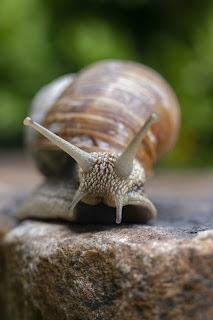Le mucus du manteau et du pied de deux escargots terrestres, Lissachatina fulica et Hemiplecta distincta, présente une activité biologique et un profil protéique différents / Snail mucus from the mantle and foot of two land snails, Lissachatina fulica and Hemiplecta distincta, exhibits different protein profile and biological activity.
Les escargots sécrètent différents types de mucus qui remplissent plusieurs fonctions et sont de plus en plus exploités pour des applications médicales et cosmétiques. Dans cette étude, les auteurs ont étudié les profils protéiques et comparé les propriétés biologiques du mucus sécrété par le manteau et le pied de deux espèces d'escargots, Lissachatina fulica et Hemiplecta distincta. Le profil protéique est différent entre les deux espèces et entre les deux parties sécrétoires. Les protéines spécifiques du manteau ont été caractérisées plus en détail et parmi elles se trouve une protéine antibactérienne, l'achacine. En conséquence, le mucus du manteau a présenté une activité antibactérienne plus élevée que celui du pied chez les deux espèces d'escargots. Le mucus de H. distincta a aussi montré des propriétés antibactériennes, mais avec une activité inférieure à celle de L. fulica. Le mucus d'escargot a également présenté une activité anti-tyrosinase et une activité antioxydante, mais sans différence significative entre le mucus du pied et celui du manteau. Ces résultats indiquent qu’il existe des différences dans les compositions protéiques et les activités biologiques entre les baves du manteau et du pied des escargots. Ces différences pourraient être associées à leurs fonctions spécifiques chez l'escargot.
ERTC : attention, les escargots géants sauvages, sont porteurs de parasites comme Angiostrongylus cantonensis et Angiostrongylus costaricensis qui peuvent provoquer des méningites chez l’homme.
Source : Snail mucus from the mantle and foot of two land snails, Lissachatina fulica and Hemiplecta distincta, exhibits different protein profile and biological activity. BMC Res Notes (2021) ; Photo de Marina Grynykha sur Unsplash
https://www.ncbi.nlm.nih.gov/pmc/articles/PMC8050916/
#activité #antityrosinase #antimicrobienne #antioxydante #escargot #mucus
< English version > Snails secrete different types of mucus that serve several functions, and are increasingly being exploited for medical and cosmetic applications. In this study, we explored the protein pattern and compared the biological properties of the mucus secreted from the mantle collar and foot of two snail species, Lissachatina fulica and Hemiplecta distincta.
Protein profile showed a different pattern between the two species and between the two secretory parts. The mantle-specific protein bands were further characterized and among them was an antibacterial protein, achacin. Accordingly, the mucus from the mantle exhibited the higher antibacterial activity than that from the foot in both snail species. The mucus from H. distincta, first reported here, also showed antibacterial properties, but with a lower activity compared to that for L. fulica. Snail mucus also exhibited anti-tyrosinase activity and antioxidant activity but with no significant difference between the foot and mantle mucus. These results indicate some different protein compositions and biological activities of snail slime from the mantle and foot, which might be associated with their specific functions in the animal and are useful for medical applications.
ERTC: beware, giant wild snails carry parasites such as Angiostrongylus cantonensis and Angiostrongylus costaricensis which can cause meningitis in humans.
Source : Snail mucus from the mantle and foot of two land snails, Lissachatina fulica and Hemiplecta distincta, exhibits different protein profile and biological activity. BMC Res Notes (2021) ; Photo by Marina Grynykha on Unsplash
https://www.ncbi.nlm.nih.gov/pmc/articles/PMC8050916/
#antityrosinase #activity #antimicrobial #antioxidant #snail #mucus



